Dodge Journey: Without intermediate shaft
NOTE: The inner tripod joints are designed with a retention feature that prevents the tripod rollers from coming out of the inner joint housing up to a specific load. If this feature is overcome and any of the rollers are pulled past the retention feature the joint will "lock-up" and no longer function properly. The entire halfshaft assembly must be replaced if this occurs.
NOTE: Some halfshafts use a tuned rubber damper weight. When replacing a halfshaft assembly, be sure the replacement halfshaft has the same damper weight as the original.
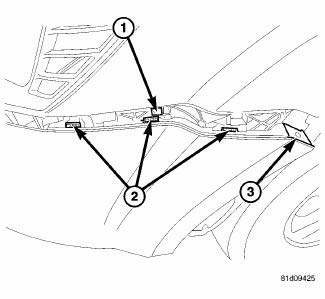
Fig. 15: View Of Manual Right Side Axle - 2.0L Gas
1. Thoroughly clean spline and oil seal sealing surface on tripod joint. Lightly lubricate oil seal sealing surface on tripod joint with fresh clean transmission lubricant.
2. Holding halfshaft assembly (1) by tripod joint and interconnecting shaft, install tripod joint into transaxle side gear as far as possible by hand. Be sure to engage splines prior to applying force.
NOTE: Attempt to remove tripod joint by hand to verify that the snap ring is fully engaged. If snap ring is fully engaged, tripod joint will not be removable from transmission by hand.
3. Forcefully push the tripod joint into the transaxle side gear, until snap-ring is fully engaged.
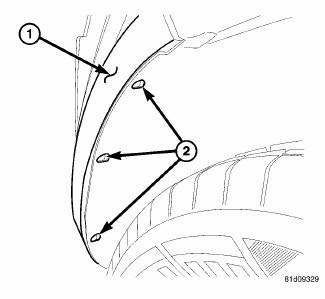
Fig. 16: Outer CV Joint Inspection
4. Clean all debris and moisture out of steering knuckle, in the area were outer CV joint (1) will be installed into steering knuckle.
5. Ensure that front of outer CV joint (2) which fits against the face of the hub and bearing is free of debris and moisture before installing outer CV joint into hub and bearing assembly.
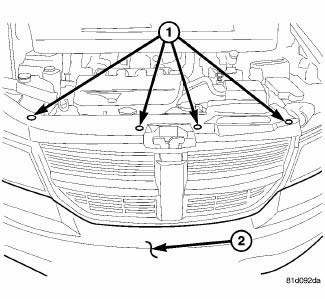
Fig. 17: Correctly Installed Eccentric Attaching Bolt
6. Slide half shaft back into front hub and bearing assembly.
CAUTION: The steering knuckle to strut assembly attaching bolts are serrated and must not be turned during installation. Install nuts while holding bolts stationary in the steering knuckle.
CAUTION: If the vehicle being serviced is equipped with eccentric strut assembly attaching bolts, the eccentric bolt must be installed in the bottom (slotted) hole on the strut clevis bracket.
7. Install steering knuckle (1) into clevis bracket (4). Install the strut damper to steering knuckle attaching bolts (3 and 3). Tighten both bolts to 88 N.m (65 ft. lbs.) plus an additional 1/4 turn.
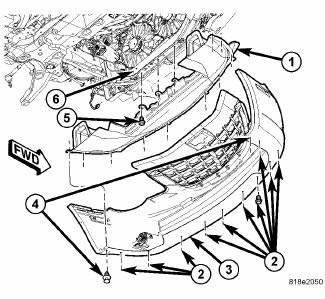
Fig. 18: Front Brake Mounting
8. Install brake disc (1) onto hub and bearing assembly (2).
9. Install front disc brake caliper (5) and adapter (6) to the steering knuckle (3). Caliper is installed by first sliding bottom of caliper assembly under abutment on steering knuckle, and then rotating top of caliper against top abutment.
10. Install the two bolts (4) that secure the front disc brake caliper and adapter to the steering knuckle.
Tighten the bolts to 169 N.m (125 ft. lbs.).
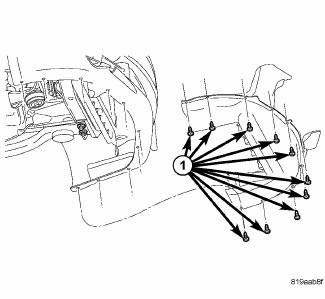
Fig. 19: View Of Hub Nut & Axle Shaft
NOTE: Always install a new hub nut. The original hub nut is one-time use only and should be discarded when removed.
11. Clean all foreign matter from the threads of the outer CV joint. Install the half shaft to hub/bearing assembly nut (1) onto halfshaft (2).
12. With the brakes applied to keep hub from turning, tighten the hub nut to 160 N.m (118 ft. lbs.).
13. Install front wheel and tire assembly. Install and tighten the wheel mounting stud nuts in proper sequence until all nuts are torqued to half the required specification. Then repeat the tightening sequence to the full specified torque of 135 N.m (100 ft. lbs.).
14. Lower vehicle.
15. Check for correct fluid level in transaxle assembly.
16. If equipped, install the engine belly pan.
 Installation
Installation
...
 With intermediate shaft
With intermediate shaft
NOTE: The inner tripod joints are designed with a retention feature
that prevents the
tripod rollers from coming out of the inner joint housing up to a specific
load. If
this feature is o ...
See also:
Solenoid, evaporative emissions purge
Operation
During the cold start warm-up period and the hot start time delay, the PCM
does not energize the solenoid.
When de-energized, no vapors are purged.
The proportional purge solenoid o ...
Installation
Fig. 67: Seal Protector
- HALFSHAFT
- SEAL PROTECTOR
1. Install driveline module to transmission jack. Secure module to jack.
2. Using Seal Protector 9099 (2), load halfshafts to differe ...
Crankshaft
Description
The crankshaft is constructed of a forged micro alloy steel. The six throw,
nine counterweight crankshaft is
supported by four select fit main bearings with the number three serving as ...
